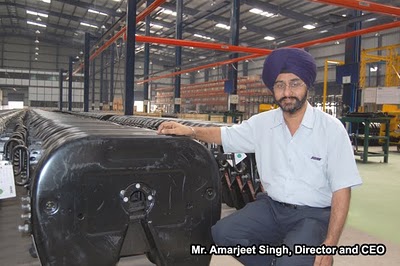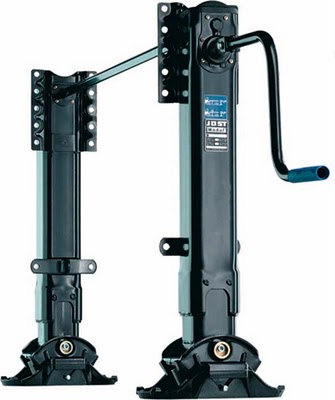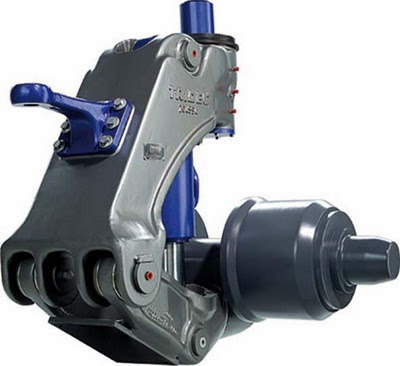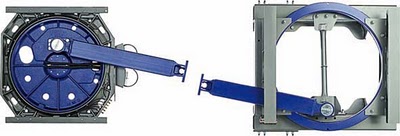 Jost India, the 100 per cent subsidiary of Jost Werke GmbH, started operations in India in 2005 and production in 2008. This is the first 100 per cent FDI in the eastern region of India. It has slowly but steadily built up a brand image which has a good recall among its prime customers, the truck OEMs and fleet owners.
Jost India, the 100 per cent subsidiary of Jost Werke GmbH, started operations in India in 2005 and production in 2008. This is the first 100 per cent FDI in the eastern region of India. It has slowly but steadily built up a brand image which has a good recall among its prime customers, the truck OEMs and fleet owners. Said GS Pradeep, Head of Sales & Marketing: “Jost India started supplies of fifth wheel couplings to Tata Motors for their different truck-tractor models. The second OE customer in the form of MAN-Force trucks was added recently. We are in talks with more Indian and European truck OEMs, and soon the customer base would increase. Jost’s product portfolio encompasses truck-tractor and trailer segments. While the truck-tractor segment is well organized, the trailer segment is still to consolidate and move towards standard specifications and models. Unless a trailer code is in place which legislates a homologation process by a statutory agency like ARAI, this segment would not be able to match the standards of truck-tractors”.
Said GS Pradeep, Head of Sales & Marketing: “Jost India started supplies of fifth wheel couplings to Tata Motors for their different truck-tractor models. The second OE customer in the form of MAN-Force trucks was added recently. We are in talks with more Indian and European truck OEMs, and soon the customer base would increase. Jost’s product portfolio encompasses truck-tractor and trailer segments. While the truck-tractor segment is well organized, the trailer segment is still to consolidate and move towards standard specifications and models. Unless a trailer code is in place which legislates a homologation process by a statutory agency like ARAI, this segment would not be able to match the standards of truck-tractors”. This is where the big challenge lies. Jost worldwide has products virtually off-the-shelf that the Indian market wants probably for the next 10 years. However, a good combination of “push and pull” effort is needed to get them on the market. A good example of this is partnering with OEMs to bring new technology like KKS (automatic coupling system) into the market as a push action and being a part of testing and certification bodies like ARAI to contribute to specifications facilitating use of such products as a pull action. Presently, a truck-tractor and trailer are married together forever due to the fact that they cannot be registered separately. This completely defeats the purpose for which an articulated vehicle is built for in the first place.
This is where the big challenge lies. Jost worldwide has products virtually off-the-shelf that the Indian market wants probably for the next 10 years. However, a good combination of “push and pull” effort is needed to get them on the market. A good example of this is partnering with OEMs to bring new technology like KKS (automatic coupling system) into the market as a push action and being a part of testing and certification bodies like ARAI to contribute to specifications facilitating use of such products as a pull action. Presently, a truck-tractor and trailer are married together forever due to the fact that they cannot be registered separately. This completely defeats the purpose for which an articulated vehicle is built for in the first place. A tractor (or a horse in Indian parlance) should be able to pull more than one trailer to ensure less down time of vehicle due to unloading and more movement of goods by picking another trailer somewhere else which is waiting for a truck-tractor to be pulled. A homologation process of the trailer (like a truck-tractor) would facilitate standardization and increase the possibility of registration of trailers independent of tractors besides ensuring less damage to roads and loss of precious lives. “With such a situation a plethora of opportunities would open up for us”, says Amarjeet Singh. Here’s how it can happen.
A tractor (or a horse in Indian parlance) should be able to pull more than one trailer to ensure less down time of vehicle due to unloading and more movement of goods by picking another trailer somewhere else which is waiting for a truck-tractor to be pulled. A homologation process of the trailer (like a truck-tractor) would facilitate standardization and increase the possibility of registration of trailers independent of tractors besides ensuring less damage to roads and loss of precious lives. “With such a situation a plethora of opportunities would open up for us”, says Amarjeet Singh. Here’s how it can happen. • With truck-tractor and trailer getting separately registered, more trailers would be built. With increased frequency of separation of tractors and trailers, use of landing gear would come into the picture, besides also testing the coupling and uncoupling mechanism of the fifth wheel coupling.
• With truck-tractor and trailer getting separately registered, more trailers would be built. With increased frequency of separation of tractors and trailers, use of landing gear would come into the picture, besides also testing the coupling and uncoupling mechanism of the fifth wheel coupling.
• Once this happens, there would be increased pressure on turnaround time and hence the KKS can come into the picture. A Jost KKS system ensures automatic process of coupling and uncoupling of a truck-tractor and trailer with the driver sitting in his cabin and pressing buttons.
• With the TRIDEC steering systems for trailers from Jost, the combination could negotiate tight corners within the city and drive upto the point of delivery or pick-up reducing the turnaround time further.
The fleet owner will not only be able to reduce the downtime of his vehicles due to the loading and unloading activities, but can also reduce his fleet size of having smaller vehicles to deliver the goods to the point of delivery or pick up. This would indeed put pressure on the popular “hub and spoke” system. “But does that not ensure faster goods movement and optimized operational cost to the fleet owners?”, asks GS Pradeep. “With increase in fuel prices virtually every other month, these equipment would, if not compensate, check the cost increase to a significant extent. We are in the process of qualifying these statements by quantifying the benefits to end customers and looking for willing ones”.